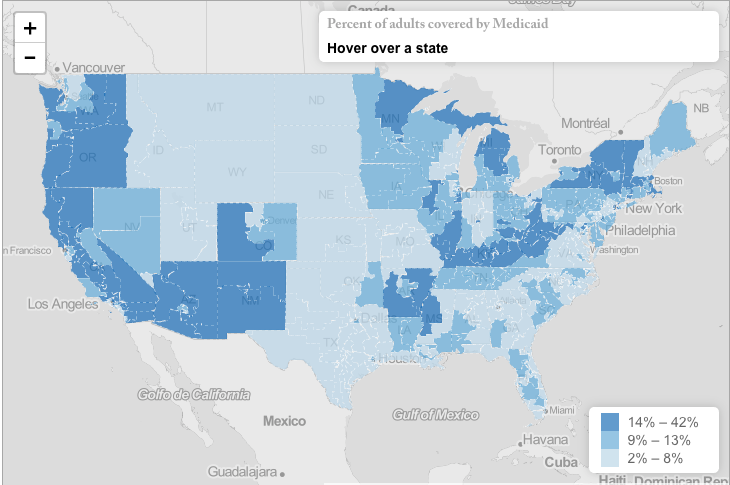Alabama
-
Nationwide Rate of Uninsured Children Reaches Historic Low
Nationwide 95.5 percent of children had health insurance in 2016, up from 95.2 percent the previous year—and up from 92.9 percent in 2013, the year before the ACA was fully implemented. While relatively few children rely on the ACA’s Marketplace for insurance, many gained coverage in Medicaid or CHIP when their parents signed up for…
-
Section 1115 Medicaid Waiver Comments
Georgetown University’s Center for Children and Families contributes an independent perspective to the public dialogue on the future of Medicaid through the lens of children and their families.
-
State CHIP Snapshots
The Role of CHIP in Children’s Coverage In 2016 the children’s health insurance coverage rate in the United States dropped to just above 95 percent, an impressive achievement. Key to this success is the Children’s Health Insurance Program, which provides coverage to children who do not qualify for Medicaid but whose families cannot otherwise afford…
-
Medicaid: The Port in a Storm for Children and Families
As Harvey and Irma remind us, natural disasters happen. And when they do, they threaten the health of children and families and the ability of providers to deliver needed services. It takes time for displaced families, providers, and communities to get back on their feet. It also takes resources. While federal Medicaid funds are always…
-
INTERACTIVE MAPS: Children Covered by Medicaid and CHIP by county, state or congressional district.
These maps show how many children are covered by Medicaid in each county and congressional district. Visit these links to view the maps, and to download handouts on your state’s coverage data: Percent of Children Covered by Medicaid/CHIP (congressional district) Percent of Children Covered by Medicaid/CHIP (county) Visit CCF’s State Resource Center for state-level data on health…
-
Report Suggests Improved Outreach and Enrollment Efforts Directed at Very Poor Parents Needed
As I was flying back from Atlanta the other night, I read a fascinating new paper by researchers at the Urban Institute (a team led by the esteemed Genevieve Kenney), which looks at adult uninsured rates and participation rates in Medicaid. In particular, the researchers examine how the number of uninsured parents and childless adults…
-
CHIP Increases Children’s Access to Dental Care and Reduces Their Unmet Dental Care Needs
By Sophia Duong Tooth decay still remains the most common chronic disease for children in the U.S. today. Progress has been made to address this problem, including a provision in CHIPRA that expanded dental coverage for all children enrolled in CHIP. CHIP has been a vital source of dental health coverage for low-to-middle income children.…
-
New Kaiser Survey Finds More States Intend to Extend Primary Care Rate Increase
By Sophia Duong In a previous post, I summarized the initiatives taken by Congress and states to extend the payment rate increase for primary care services, set to expire on December 31, 2014. At the time, six states were reported to finance the primary care bump through 2015 with their own state funds. Now, Kaiser…
-
Medicaid Matters For Children: Alabama’s Investment in Extending the Medicaid Payment Increase
By Dr. Marsha Raulerson, Fellow of the American Academy of Pediatrics Across the country, Medicaid and the Children’s Health Insurance Program (CHIP) provide health coverage to more than 43 million children, including half of all low-income children in the United States. This summer, I cared for one of those children. In August, a 17 year old…
-
As Clock Ticks on CHIP Funding, Experts Work to Explain its Importance to Kids
The Children’s Health Insurance Program and Medicaid are the MVPs of children’s coverage. About 8 million children with low to moderate incomes are covered by CHIP while 39 million children are covered under Medicaid. The Affordable Care Act built upon the success of these two vital health coverage programs in many ways including an extension…
-
Infographic: Southerners More Likely to be Poor, Uninsured and Live in a State that Denies Them Medicaid
A new infographic from the Kaiser Family Foundation this week lays out some of the ironies of the decision by many southern states not to accept federal money to expand Medicaid health coverage to their lowest-income citizens. With higher rates of poverty and adults more likely to be uninsured, the need for affordable coverage is…
-
Many Southern States Miss Opportunity to Address Health Disparities
By Tara Mancini A new report from the Kaiser Commission on Medicaid and the Uninsured (KCMU) indicates that a little more than half (53%) of uninsured people of color have family income at or below 138% and therefore should qualify for Medicaid in 2014 as the ACA originally intended. Yet, almost a third (30%) of…
-
Children’s Health Coverage on the Eve of the Affordable Care Act
Georgetown University Center for Children and Families researchers analyzed health insurance data from the Census Bureau’s annual American Community Survey to get a closer look at children’s coverage trends. On the eve of the implementation of the Affordable Care Act coverage expansions, the authors found important lessons from the success the U.S. has had in covering children. The number of uninsured…
-
Kaiser Report Finds More Than 5 Million Will Fall Into Coverage Gap Created by States Failing to Expand Medicaid
A federally-funded Medicaid option for more uninsured adults is an important cornerstone of the Affordable Care Act, however, an estimated 5,161,820 uninsured individuals will be left behind because they live in states that have not yet accepted the Medicaid expansion option. Those who fall into the gap earn too much to qualify under their state’s…
-
Census Shows Uninsured Rate Declines for Children; Poverty Up in Southern Region
The U.S. Census data released today held some good news on the health coverage of America’s children and families. While poverty remained unacceptably high, the rate of uninsured children continued to decline. The uninsured rate for children declined from 9.4 percent in 2011 to 8.9 percent in 2012. This is mainly due to the success…
-
Getting Into Gear for 2014: Findings from a 50-State Survey of Eligibility, Enrollment, Renewal, and Cost-Sharing Policies in Medicaid and CHIP, 2012-2013
As 2013 begins, implementation of the major provisions of the ACA, including its coverage expansions, is less than a year away. Following the Supreme Court ruling to uphold the ACA and the 2012 elections, efforts to prepare for 2014 are moving into high gear in many states. The majority of states are capitalizing on web-based…
-
23 States Receive CHIPRA Performance Bonuses for Removing Barriers and Enrolling Children in Health Coverage
Demonstrating that covering kids is still a very high priority across the nation, twenty-three states earned CHIPRA performance bonuses for improving access to children’s health coverage and successfully enrolling eligible children. The states will split a total of nearly $306 million. The 23 states include: Alabama, Alaska, Colorado, Connecticut, Georgia, Idaho, Illinois, Iowa, Kansas, Maryland, Michigan, Montana,…
-
Uninsured Children 2009-2011: Charting the Nation’s Progress
Georgetown University Center for Children and Families researchers analyzed health insurance data from the Census Bureau’s annual American Community Survey to get a closer look at children’s coverage trends. The authors found that the nation continues to make steady progress covering children, despite no reduction in the number of children living in poverty. A strong commitment to…
-
State Fact Sheets Highlight Importance of Medicaid Coverage for Children
By Ielnaz Kashefipour, American Academy of Pediatrics The American Academy of Pediatrics, in partnership with the Children’s Hospitals Association (formerly NACHRI), this week produced updated state-by-state fact sheets that explain the importance of the Medicaid program for children. These fact sheets are used in federal and state advocacy efforts to protect the Medicaid program from…
-
Fresh Insights into Strategies and Messages for Enrollment in Medicaid and the Exchange
The Robert Wood Johnson Foundation recently released new research to help states identify messages that will encourage enrollment in Medicaid in 2014 when minimum eligibility levels are expanded to 133% FPL. The research also explores issues relating to state Exchanges, including attitudes about enrolling and choosing health insurance online. It was conducted in three states:…








